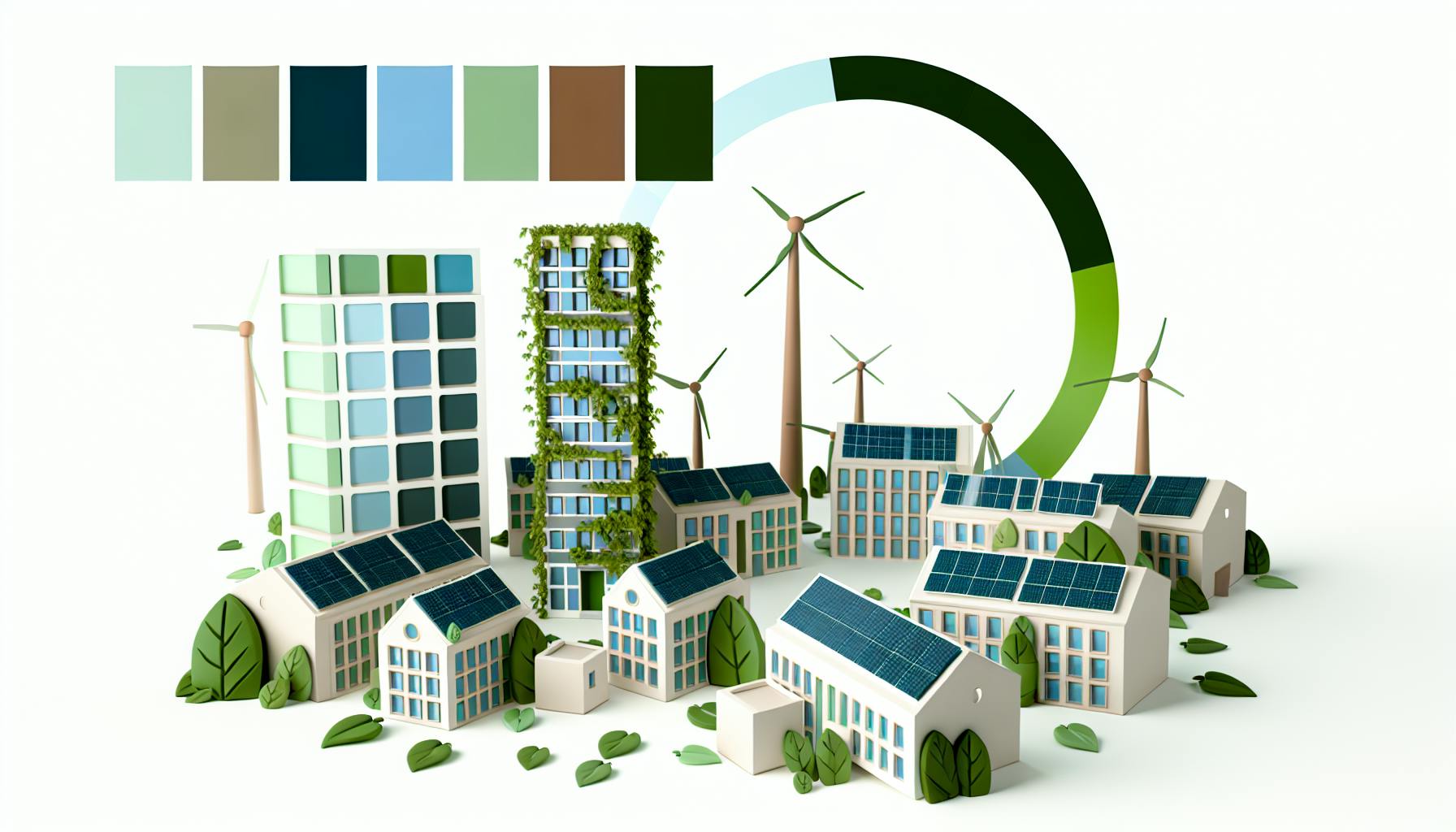Managing greenhouse gas production is complex, but essential for SMEs to understand.
This guide will demystify carbon accounting, clearly explain key concepts, and showcase solutions to streamline emissions tracking.
You'll get an overview of greenhouse gas metrics, learn how to calculate your emissions baseline, leverage SaaS platforms for monitoring, and more. By the end, you'll have strategies to navigate reporting standards and realize benefits like attracting green investors or enhancing your reputation.
Unveiling the Essentials of Greenhouse Gas Production and Carbon Accounting
As greenhouse gas emissions continue to rise, small and medium enterprises are facing increasing pressure from regulators, investors, and consumers to understand and reduce their carbon footprints. This article provides guidance on navigating carbon accounting as a critical first step.
Defining Key Terms and Metrics in Carbon Accounting
Some key terms and metrics in greenhouse gas accounting include:
- Greenhouse gases (GHG): Gases like carbon dioxide, methane, and nitrous oxide that absorb infrared radiation and warm the atmosphere.
- Carbon footprint: The amount of greenhouse gases emitted by a person, organization, process or product. Usually measured in tons or kilograms of carbon dioxide equivalent.
-
Scopes 1, 2 and 3: Categories defined by the Greenhouse Gas Protocol that allow organizations to categorize direct and indirect emissions sources in their value chain.
- Scope 1 covers direct emissions from owned or controlled sources.
- Scope 2 covers indirect emissions from the generation of purchased energy.
- Scope 3 includes all other indirect emissions in the value chain.
- SBTi: The Science Based Targets initiative helps companies set emissions reductions targets consistent with climate science. Over 1,000 companies have joined.
Accurately tracking greenhouse gas emissions requires understanding key protocols like the GHG Protocol as well as data collection methodologies.
Calculating Your Emissions Baseline: Understanding CO2 Emissions by Source
To calculate a greenhouse gas emissions baseline, companies need to identify major sources of emissions across their operations and value chains. Common sources include:
- Energy use in offices, warehouses, retail stores or manufacturing facilities
- Fuel use in delivery vehicles or corporate jet travel
- Supply chain impacts from sourcing materials or outsourced activities
Data can be collected from utility bills, fuel purchases records, sustainability reports from suppliers and life cycle analyses. When relevant data is not available, reasonable estimates can be made based on industry benchmarks.
With a detailed emissions inventory, companies can understand the biggest contributors to their carbon footprint and identify “hot spots” to target for reductions.
Setting Science-Based Targets for Greenhouse Gas Reduction
Adopting a science-based target (SBT) is considered best practice for goal setting. An SBT specifies how much and how quickly a company needs to reduce emissions to help meet the Paris Agreement goals.
Over 1,100 companies have approved science-based targets so far. Key steps to develop one include:
- Calculate baseline emissions
- Model future “business as usual” projections
- Commit to reduce emissions at the pace and scale defined by climate science
- Have targets officially validated by SBTi
Customized SBTs help companies contribute meaningfully to global climate action while improving operational efficiency.
Leveraging SaaS Platforms for Efficient Greenhouse Gas Tracking
Sustainability management software provides automation for data collection and centralized reporting of greenhouse gas inventories. Capabilities include:
- Connections to data sources: Auto-sync emission factors or integrate sensor readings and financial data.
- Calculation engines: Apply product or company-specific methodologies for accurate carbon accounting.
- Data validation: Check data inputs and flag outliers to prevent errors.
- Custom reporting: Produce reports tailored to various stakeholder needs.
By eliminating manual processes, SaaS tools boost data accuracy and free up staff to focus on climate strategy.
Visualizing and Reporting Your Carbon Footprint
Compelling visualizations and reporting help demonstrate sustainability progress to stakeholders. Best practices include:
- Interactive dashboards: Allow users to segment emissions data by source, business unit or timeframe.
- Infographics: Use charts, graphs and illustrations to highlight trends and performance against targets.
- Benchmarking: Compare footprint metrics against industry peers.
- Storytelling: Put data in context by connecting it to business initiatives and climate impacts.
Effective reporting builds trust and transparency while ensuring accountability to defined emissions goals.
How are greenhouse gases produced?
Greenhouse gases like carbon dioxide (CO2), methane (CH4), and nitrous oxide (N2O) are produced from both natural processes and human activities. The largest source of greenhouse gas emissions comes from burning fossil fuels like coal, oil, and natural gas for electricity, heat, and transportation.
Other major sources include:
- Deforestation and land use changes
- Livestock farming and agricultural practices
- Some industrial processes and product uses
- Waste decomposition
The way we produce and consume energy is the main driver of rising greenhouse gas levels. As we burn more fossil fuels to power homes, businesses, travel, etc., more heat-trapping emissions are released into the atmosphere. This causes the greenhouse effect to intensify, trapping more heat and warming the planet.
Adopting renewable energy sources like solar, wind, hydro, and geothermal can significantly reduce greenhouse gas production. Improving energy efficiency, changing agricultural and forestry practices, reducing waste, and making lifestyle changes can also curb emissions. Automating carbon accounting with software like EcoHedge provides the tracking and insights needed to make progress.
What are the top 3 producers of greenhouse gases?
China, the United States, and the European Union are the world's top emitters of greenhouse gases.
China
China produces the most greenhouse gas emissions globally - over one-quarter of total global emissions. Their heavy reliance on coal for electricity generation is a major contributor. However, China has also invested more than any other country in renewable energy.
United States
The United States comes in second, contributing 15% of global emissions. Transportation and electricity generation are the largest sources. Per capita emissions in the US are among the highest globally due to high consumption patterns.
European Union
The 27 member states of the European Union collectively account for about 10% of global emissions. Most emissions come from electricity and heat generation, agriculture, and transportation. The EU aims to be climate-neutral by 2050.
What is the biggest contributor to greenhouse gases?
The largest source of greenhouse gas emissions globally comes from burning fossil fuels such as coal, oil, and natural gas. According to recent data, fossil fuel combustion accounts for over 75% of total global greenhouse gas emissions.
Within that, specifically the burning of coal, oil, and gas for electricity and heat generation makes up about 25% of total emissions. Transportation-related emissions from cars, trucks, ships, trains, and planes using fossil fuels comprise around 14% of the total. Additional major sources are agriculture, forestry, industries like cement production, and waste management, which combined are responsible for the remaining emissions.
As these greenhouse gases are released and accumulate in the atmosphere, they trap more of the sun's heat, causing worldwide temperatures to rise steadily over the past century. This human-caused climate change is already triggering more extreme weather events, ice melt, and sea level rise around the globe. But by measuring and tracking emissions with carbon accounting software, organizations can pave the path to reducing reliance on fossil fuels.
sbb-itb-919600f
Is producing greenhouse gases good?
Greenhouse gases play an important role in regulating Earth's temperature and making conditions livable. However, human activities like burning fossil fuels have increased greenhouse gas emissions to unsustainable levels, trapping more heat and causing widespread environmental changes.
Adopting renewable energy sources and ecohedge.com/blog/carbon-accounting-tool-streamlining-compliance-and-reporting/">using carbon accounting tools can help reduce emissions and mitigate climate change risks. SaaS solutions like EcoHedge provide automated greenhouse gas tracking to help businesses monitor their impact and make informed decisions to curb emissions. Through collaborative action, we can transition to more sustainable practices.
Comprehensive Analysis of Greenhouse Gas Emissions by Source and Sector
Greenhouse gas emissions refer to the release of gases such as carbon dioxide, methane, nitrous oxide, and fluorinated gases into the atmosphere. These gases trap heat and are the leading cause of global climate change. Understanding emissions by source and sector provides valuable insights for policymakers and businesses seeking to curb emissions.
Overview of Global Greenhouse Gas Emissions by Sector 2022
The latest data from 2022 shows that electricity and heat production contribute the largest share of global greenhouse gas emissions at 31%. This can be attributed to the widespread burning of fossil fuels like coal and natural gas to generate electricity.
Transportation is the second highest emitting sector at 16.2% of global emissions. Most transportation still relies on the internal combustion engine burning fossil fuel. Agricultural activities account for 13.8% driven by livestock rearing, soil management, and rice cultivation. Manufacturing industries and construction make up 13.2% due to energy-intensive production processes and the use of greenhouse gases like HFCs in insulation foam.
Other major contributors include forestry and land-use changes at 5.9%, buildings at 5.6%, fugitive emissions from the production of fossil fuels at 4.1%, and waste management activities at 3.2%. The remaining 7% comes from other sources.
To meet global climate goals, deep decarbonization is required across all high-emitting sectors. This means rapidly transitioning from fossil fuels to renewable energy for power, electrifying transportation, implementing regenerative agricultural practices, boosting energy efficiency in buildings and industry, conserving forests, and improving waste management.
Examining Greenhouse Gas Emissions by Country Percentage
The top three greenhouse gas emitting countries in 2022 were China at 26.2%, the United States at 14.5%, and India at 6.8%. These three countries collectively account for nearly half of total global emissions.
The next seven major emitters with percentages between 1 to 2 percent are Russia, Japan, Germany, Iran, South Korea, Saudi Arabia, and Indonesia. Over 160 countries emit less than 1% each but still have a role to play.
Developed countries like the U.S. have much higher per capita emissions compared to developing countries. So equitable climate solutions require differentiated responsibilities aligned with respective capabilities. For example, rich countries have greater means to invest in clean technology at scale versus poorer nations.
Still, all major emitters must act with urgency across energy, transportation, buildings, industry and agriculture sectors. Policy coordination through multilateral climate agreements brings hope along with public-private partnerships, technology transfer and climate financing.
Navigating Disclosure and Compliance in Greenhouse Gas Reporting
As climate change continues to threaten communities and economies globally, regulations around greenhouse gas emissions reporting and disclosure have rapidly evolved. Small and medium-sized enterprises (SMEs) contribute over 50% of greenhouse gas production yet often lack resources to track emissions fully. Adopting SaaS solutions can enable SMEs to collect quality data and meet compliance needs proactively.
Key Regional & Industry Standards for Emissions Disclosure
Major reporting frameworks SMEs should be aware of include:
- Task Force on Climate-Related Financial Disclosures (TCFD): Requires climate-related financial disclosures on governance, strategy, risk management and metrics/targets. Applicable across sectors and jurisdictions.
- CDP: Non-profit running a global disclosure system for companies to report environmental impacts to investors and purchasers. Covers climate change, water security and deforestation.
- Global Reporting Initiative (GRI): Reporting standard for ESG impacts including emissions, energy, biodiversity and compliance. Used internationally by businesses of all sizes.
While complex, understanding major frameworks helps build comprehensive and globally aligned disclosure programs.
Harnessing SaaS for Streamlined Data Collection and Reporting
By automating data collection and report generation, SaaS solutions enable SMEs to:
- Track emissions across scopes 1, 2 and 3 as per GHG Protocol
- Access benchmarking data to contextualize footprint
- Model abatement potential of various reduction activities
- Generate investor-grade disclosures including TCFD and CDP-aligned reports
Consolidating disclosures into one system reduces reporting burden significantly.
Verifying Your Inventory for Accuracy and Transparency
To ensure high data quality, SMEs can undertake:
- Internal audits: Cross check completeness of data sources/calculations
- External verification: Independent reviewer assesses adherence to reporting standards
Verification, though not mandatory presently, signals commitment and enhances credibility.
Strategies for Communicating Greenhouse Gas Performance Externally
Beyond formal disclosures, SMEs can communicate sustainability initiatives across channels:
- Website sustainability pages
- Social media campaigns
- Infographics in product packaging
- Point-of-sale signage on green buildings
Multi-channel outreach aids customer education and brand differentiation.
Future-Proofing for Upcoming Regulations in Emissions Accounting
With major economies proposing climate disclosure legislation, SMEs must prepare for expanded mandates. Key developments include:
- EU's Corporate Sustainability Reporting Directive
- US's Federal Sustainability Reporting requirements
- UK's Sustainability Disclosure Requirements
Proactively adopting reporting tools enables shaping better policy through industry consultation.
Realizing the Benefits of Decarbonization in Business
Decarbonization presents a timely strategic opportunity for businesses to enhance their competitive positioning while building a more sustainable future. By measuring, reporting, and reducing greenhouse gas emissions across operations and supply chains, companies can realize both near and long-term business value.
Enhancing Reputation and License to Operate with Lower Emissions
Sustainability leadership builds stakeholder trust and goodwill vital for any enterprise's social license to operate. A recent survey showed 76% of job seekers view eco-friendly practices as an important factor when evaluating employers. Companies recognized for responsibly managing their greenhouse gas production reap recruiting advantages amidst the war for talent. They also tend to have 31% higher employee productivity resulting from genuine pride in their employer.
Community relations further benefit from substantive climate action instead of greenwashing. Consumers increasingly demand brands walk the talk through measurable footprint reductions aligned to science-based targets. Success here pays dividends in securing permits for business expansion and avoiding project delays from local opposition.
Attracting Green Investments and Improving Access to Capital through Emission Reductions
In 2022, sustainability-themed investments topped $649 billion in the United States alone as Environmental, Social, and Governance (ESG) factors gain prominence. Recent research discovered 80% of lenders already link climate risk management to favorable loan terms while a third outright require measurable decarbonization plans from borrowers. This pattern will likely accelerate as stakeholders pressure financial institutions to account for emissions from their lending activities.
Ambitious emission reduction programs also make companies attractive for impact investors eager to back tangible climate solutions. These value-aligned growth capital sources reached over $1.3 trillion in 2020. The resulting access to green financing can fuel strategic projects that curb greenhouse gas production.
Driving Innovation Across Operations to Curb Greenhouse Gas Production
The urgent quest to achieve net-zero emissions by 2050 necessitates breakthrough innovations minimizing industrial greenhouse gas production. The hidden opportunity from sustainability pressures is how they inevitably spark operational excellence programs generating both environmental and economic gains.
The journey typically starts with comprehensive carbon accounting illuminating the largest sources of emissions across facilities, fleets, and supply chains. Companies then conduct resource efficiency audits uncovering energy, water, and waste reductions that translate to immediate cost savings. Further analyzing product lifecycles reveals material or design changes that curb emissions while retaining function. Cross-departmental collaboration also breeds creative emission reduction tactics and even new green products and revenue streams.
Building Business Resilience to Climate Impacts and Regulatory Shifts
Proactively assessing both transition and physical climate risks better equips companies to navigate coming business disruptions as the world decarbonizes. Measuring current greenhouse gas production and reduction opportunities facilitates accurate scenario analyses on fluctuating energy prices, carbon taxes, supply chain interruptions from extreme weather and more. Such quantifiable insights empower agile strategies that ensure continuity of operations and supply.
Emission quantification also eases compliance with expanding climate disclosure legislation and avoided costs from non-compliance. In 2021, over 1,100 large corporations faced mandatory climate risk reporting under TCFD guidelines. Over 100 countries likewise either implemented carbon pricing schemes or plan to by 2030. Those better understanding their environmental footprint will maintain competitiveness amidst the regulatory shift.
Aligning with Shifting Customer Expectations on Greenhouse Gas Emissions
Customer sentiment continues trending towards consciously supporting businesses helping solve climate change instead of exacerbating it. A recent survey showed 65% of shoppers are willing to pay more for sustainable products while 76% consider sustainability when making purchase decisions. This preference will only grow stronger over time.
Leading companies recognize decarbonization as a prerequisite for maintaining relevance and market share. Those failing to publicly report and reduce emissions will struggle to secure sales amid rising green buyer expectations. However, substantively lowering environmental footprint offers a powerful market differentiation advantage. It signals a forward-thinking brand deserving of customer loyalty and prime shelf space.
Synthesis: Steering SMEs Towards Sustainable Greenhouse Gas Management
As the impacts of climate change intensify globally, small and medium enterprises (SMEs) have a pivotal role to play in curbing greenhouse gas emissions. Comprehensive carbon accounting enables SMEs to accurately measure their overall greenhouse gas footprint across direct and indirect emission sources. This empowers them to make informed decisions to reduce emissions and communicate progress to stakeholders.
Adopting automated solutions like EcoHedge to track greenhouse gas production simplifies this complex accounting process. The software seamlessly generates comprehensive emissions reports covering all relevant Greenhouse Gas Protocol categories and scopes. This saves SME managers time while ensuring consistent and auditable sustainability reporting.
Embracing carbon accounting positions SMEs to thrive in an increasingly carbon-constrained world. Proactively managing greenhouse gas production allows companies to mitigate regulatory and reputational risks, unlock efficiency gains, and satisfy evolving customer and investor expectations. As global momentum builds towards net-zero emissions, SMEs have a strategic imperative to understand and reduce their carbon impacts. Carbon accounting solutions make this transition achievable amidst small teams and budgets.
EcoHedge empowers SMEs to overcome barriers to effective carbon management using intuitive technology. By automating greenhouse gas accounting, EcoHedge allows SMEs to accurately benchmark emissions, identify reduction opportunities, engage stakeholders, and track progress towards science-based climate targets. Its specialized solutions enable SMEs to lead on climate action in their sectors worldwide.



